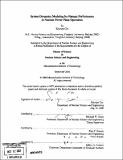System dynamics modeling for human performance in nuclear power plant operation
Author(s)
Chu, Xinyuan
DownloadFull printable version (4.310Mb)
Other Contributors
Massachusetts Institute of Technology. Dept. of Nuclear Science and Engineering.
Advisor
Michael W. Golay.
Terms of use
Metadata
Show full item recordAbstract
Perfect plant operation with high safety and economic performance is based on both good physical design and successful organization. However, in comparison with the affection that has been paid to technology research, the effort that has been exerted to enhance NPP management and organization, namely human performance, seems pale and insufficient. There is a need to identify and assess aspects of human performance that are predictive of plant safety and performance and to develop models and measures of these performance aspects that can be used for operation policy evaluation, problem diagnosis, and risk-informed regulation. The challenge of this research is that: an NPP is a system that is comprised of human and physics subsystems. Every human department includes different functional workers, supervisors, and managers; while every physical component can be in normal status, failure status, or a being-repaired status. Thus, an NPP's situation can be expressed as a time-dependent function of the interactions among a large number of system elements. The interactions between these components are often non-linear and coupled, sometime there are direct or indirect, negative or positive feedbacks, and hence a small interference input either can be suppressed or can be amplified and may result in a severe accident finally. This research expanded ORSIM (Nuclear Power Plant Operations and Risk Simulator) model, which is a quantitative computer model built by system dynamics methodology, on human reliability aspect and used it to predict the dynamic behavior of NPP human performance, analyze the contribution of a single operation activity to the plant performance under different circumstances, diagnose and prevent fault triggers from the operational point of view, and identify good experience and policies in the operation of NPPs. (cont.) Regarding the human reliability analysis function, the partial Standardized Plant Analysis Risk Human Reliability Analysis (SPAR-H) method was applied. Performance Shaping Factors (PSFs) were employed to analyze the influence of human performance indicators already existing in ORSIM. Based on the human performance model, an operation case study was investigated. A series of carefully chosen candidate policies were tested on a computerized model that represents the structure, processes, and interactions of the underlying target NPP systems. These candidates included: (1) New management system application; (2) Personnel population change, (3) Planning delay, and (4) Tolerance to surprise workload.
Description
Thesis (S.M.)--Massachusetts Institute of Technology, Dept. of Nuclear Science and Engineering, 2006. Includes bibliographical references (p. 62).
Date issued
2006Department
Massachusetts Institute of Technology. Department of Nuclear Science and EngineeringPublisher
Massachusetts Institute of Technology
Keywords
Nuclear Science and Engineering.